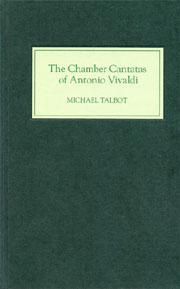Book contents
- Frontmatter
- Contents
- List of music examples
- List of tables
- Preface
- Conventions and abbreviations
- 1 The Rediscovery of Vivaldi's Cantatas
- 2 The Cantata Genre
- 3 Vivaldi and the Voice
- 4 The Mantuan Cantatas
- 5 Cantatas of the Middle Years
- 6 The Dresden Cantatas
- 7 Vivaldi's Cantatas in Perspective
- Glossary
- List of Vivaldi's cantatas published in the New Critical Edition
- Spurious works
- Bibliography
- Index to musical works
- General index
6 - The Dresden Cantatas
Published online by Cambridge University Press: 12 September 2012
- Frontmatter
- Contents
- List of music examples
- List of tables
- Preface
- Conventions and abbreviations
- 1 The Rediscovery of Vivaldi's Cantatas
- 2 The Cantata Genre
- 3 Vivaldi and the Voice
- 4 The Mantuan Cantatas
- 5 Cantatas of the Middle Years
- 6 The Dresden Cantatas
- 7 Vivaldi's Cantatas in Perspective
- Glossary
- List of Vivaldi's cantatas published in the New Critical Edition
- Spurious works
- Bibliography
- Index to musical works
- General index
Summary
Vivaldi and Dresden
After the Ospedale della Pietà in Venice, the institution with which Vivaldi enjoyed the longest professional relationship was the court of Dresden, seat of the Saxon electors, who, during the same period (1712–40), were also kings of Poland. The seeds for this association were sown by the accession, in 1694, of Friedrich August I (1670–1733), known as ‘Augustus the Strong’. In 1696 the Polish throne became vacant. This monarchy was elective, and in a disputed contest Friedrich August emerged as the winner, being crowned as Augustus II at Cracow on 15 September 1697. A condition of becoming king of Poland was that he should embrace Catholicism. Saxony was staunchly Lutheran, and the elector initially made his conversion a merely personal matter. The electress, Christiane Eberhardine, and most of the court remained true to Protestantism.
In 1704 a Russian–Swedish alliance ousted Friedrich August as king of Poland in favour of his rival, Stanisław Leszczyński (father of the princess whose marriage to Louis XV Vivaldi was later to celebrate in RV 687). The elector did not, however, lose hope of regaining his throne. He refused to return to Lutheranism, and in 1708 enraged his court and subjects by transforming Dresden's former opera house into a Catholic court chapel (katholische Hofkirche). His patience was rewarded, for in 1709 the Russians and Swedes fell out, so that in the following year Friedrich August was able to reclaim the Polish throne.
- Type
- Chapter
- Information
- The Chamber Cantatas of Antonio Vivaldi , pp. 164 - 187Publisher: Boydell & BrewerPrint publication year: 2006



